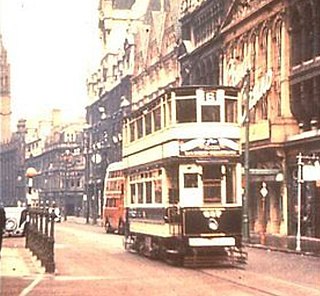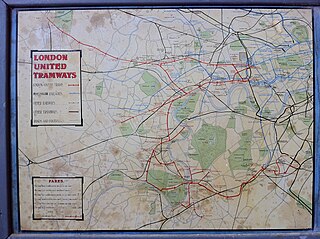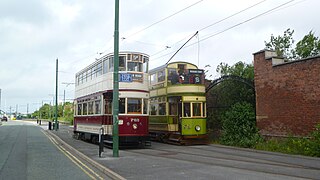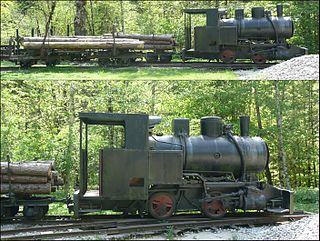
Trams are a major form of public transport in Melbourne, the capital city of the state of Victoria, Australia. As of May 2017, the Melbourne tramway network consists of 250 kilometres of double track, 493 trams, 24 routes, and 1,763 tram stops. The operator Yarra Trams claims the system is the largest operational urban tram network in the world. Trams are the second most used form of public transport in overall boardings in Melbourne after the commuter railway network, with a total of 206 million passenger trips in 2017-18.

The Kingsway Tramway Subway is a cut-and-cover Grade II Listed tunnel in central London, built by the London County Council, and the only one of its kind in Britain. The decision in 1898 to clear slum districts in the Holborn area provided an opportunity to use the new streets for a tramway connecting the lines in the north and south. Following the pattern of tramways in New York and Boston, it was decided to build this as an underground connection.

The Douglas Bay Horse Tramway on the Isle of Man runs along the seafront promenade for approximately 1.6 miles (2.6 km), from the southern terminus at the Victoria Pier, adjacent to the Sea Terminal, to Derby Castle, the southern terminus of the Manx Electric Railway, where the workshops and sheds are located. It is a distinctive tourist attraction.

There have been two separate generations of trams in London, from 1860 to 1952 and from 2000 to the present. There were no trams at all in London between 1952 and 2000.

A tram-train is a light-rail public transport system where trams run through from an urban tramway network to main-line railway lines which are shared with conventional trains. This combines the tram's flexibility and accessibility with a train's greater speed, and bridges the distance between main railway stations and a city centre.

The Howth Tram was a tram which served Howth Head, near Dublin, Ireland. The termini were at Sutton railway station and Howth railway station. It operated from June 1901 to 31 May 1959 and was run by the Great Northern Railway (Ireland), which viewed it as a way to bring more customers to its railway stations at Sutton and Howth.

Trams in Saint Petersburg are a major mode of public transit in the city of Saint Petersburg, Russia. Saint Petersburg once had the largest tram network in the world, consisting of about 340 kilometres (210 mi) of unduplicated track in the late 1980s. However, since 1995 the tramway network has declined sharply in size as major portions of track were removed, particularly in the city centre. Saint Petersburg lost its record to Melbourne, Australia. While it still had 285 kilometres (177 mi) of length in 2002, by early 2007 the tram network's had declined to just over 220 kilometres (140 mi), and by the 2010s operated on just 205.5 kilometres (127.7 mi) of network.

Calcutta Tramways Company (CTC) is a state-run company that operates trams and buses in and around Kolkata in West Bengal, India. The Kolkata tram is the only operating tramway in India and is the oldest electric tram in Asia, operating since 1902.

The Kingston upon Hull tramway network was a network of 4 ft 8 1⁄2 in standard gauge tram lines following the five main roads radially out of the city centre of Kingston upon Hull, East Riding of Yorkshire, England. Two of these lines went west, and two east. The fifth went to the north, and branched to include extra lines serving suburban areas. Additionally a short line linked the city centre to the Corporation Pier where a ferry crossed the Humber Estuary to New Holland, Lincolnshire.

Birmingham Corporation Tramways operated a network of tramways in Birmingham from 1904 until 1953. It was the largest narrow-gauge tramway network in the UK, built to a gauge of 3 ft 6 inches. It was the fourth largest tramway network in the UK behind London, Glasgow and Manchester.

London United Tramways Company Limited was an operator of trams and trolleybuses in the western and southern suburbs of London, UK, from 1894 to 1933, when it passed to the London Passenger Transport Board.

Leeds Corporation Tramways formerly served the city of Leeds, England. The original trams were horse-drawn, but, by 1901, electrification had been completed. The tramway opened on 29 October 1891
Dover Corporation Tramways was the operator of the second tramway system built in the United Kingdom. It was in operation from 1897 to 1936. The worst ever tram accident in the United Kingdom occurred on the system in 1917.
Between 1901 and 1949 Manchester Corporation Tramways was the municipal operator of electric tram services in Manchester, England
At its peak in 1928 the organisation carried 328 million passengers, on 953 trams, via 46 routes, along 292 miles (470 km) of track.

Wirral Tramway is a heritage tramway opened in 1995 by the Wirral Borough Council and Hamilton Quarter partnership and was operated by Blackpool Transport Services until 2005 when the council took over the licence to run the tramway.

Gloucester Corporation Tramways operated an electric tramway service in Gloucester between 1904 and 1933.

The Blackpool and Fleetwood Tramroad operated a tramway service between Blackpool and Fleetwood between 1898 and 1920.

















